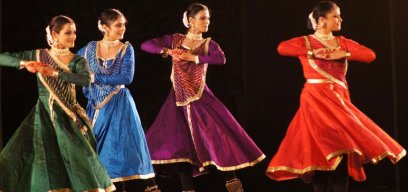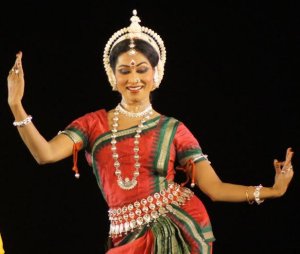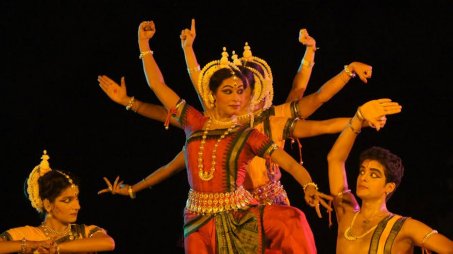
|   |

|   |
Unparalleled dancing - Shveta Arora e-mail: shwetananoop@gmail.com Photos: Anoop Arora November 6, 2014 That which is unparalleled, unmatched, beyond comparison, that which cannot be fathomed is truly Ananya. This is the title for the classical dance festival held at the Purana Quila in Delhi. A walk through a path flanked by trees, flickering diyas at the entrance to welcome you, and the arches of the lighted old fort to enthrall you, is just the beginning of the experience. The festival is organized by Seher and Department of Art, Culture and Languages, Govt. of India.   Gauri Diwakar and group Regarding the technical aspects of the traditional Kathak repertoire, Gauri kept her focus on vilambit, madhyam and dhrut. Vilambit had thaat, amaad, pairon ki uthan and in madhyam, she used parmelu and some brief tihais. In dhrut, which was a tarana, she used gat, tihai, jugalbandi, paran and footwork. She tried to put in all that she could. The entire production was in three parts. The first part was about eyes, which can be used to express yourself. Eyes are a medium of communication. Just as bees are attracted towards a flower, people are attracted towards eyes. The eyes express emotions like love, anger and jealousy. Gauri depicted the piece by showing Radha wearing her ornaments. The focus was on her eyes, which were described as Ratanare or as if made of precious stones. The eyes were shown to express love, companionship, charisma, passion, lust, caring and pride. The dancers compared the eyes to bees, emulating their movements with their hands. The second piece was a solo by Gauri. The beauty of Radha is described from her head to her bust. She is compared to the moon, the zari of her sari, her jewellery, her firm breasts covered by a kanchuki or a blouse, all shining in the moonlight. In the piece, the other dancers depicted a deer, a butterfly and a peacock, with aesthetic movements. Gauri, as Radha going to meet her lover Krishna, did some mesmerizing nritya with chakkars. The lyrics described the beauty of Radha, which shames the moon. There was a melodious flute interlude between the second and third pieces. About the third piece, Gauri said, “This part is about her feet, the payal and nupur on them. She is emoting through her feet and her nupur does the talking. This is what we call the aharya abhinaya, in which the jewellery is used as an aid to communication. The text that I have chosen is from the Ritikaal of the history of Hindi literature. Ritikaal is criticized for describing women as an object of beauty, but without personality or brains. For me, my heroine is as beautiful within as she is on the outside. The beauty inside is the eternal truth and that is what surfaces to the exterior. In the end, I show Radha as a lotus. During my research, I found a lot of references to Radha being like a lotus. The bees are the attributes of this beauty, which keep hovering around her, but do not meet her. In the end, the lotus closes and all the attributes are assimilated within her.” The dancers came in colorful costumes and their footwork was the main component of this piece. The footwork progressed from slow to quick movement and then clapping and tapping. And then finally, Gauri forms the lotus and the rest of the dancers as bees are absorbed within her. The entire performance had mesmerizing music, vocals and excellent pakhavaj playing in the background. The dancers in Gauri’s group included Anukriti Vishwakarma, Amrapali Bhandari, Meera Rawat and Shivalika Kataria. Concept and choreography was by Gauri Diwakar, mentored by Aditi Mangaldas. Text sourced by Shubha Mudgal and music composition by Shubha Mudgal and Aneesh Pradhan. Song was by Lal Balbir and couplets by Sayed Ghulam Nabi Rasleen. The musicians included Yogesh Gangani on tabla, Mahaveer Gangani on pakhavaj, Samiullah on vocals and harmonium, Kamal Ahmed on sarangi, Uma Shanker on sitar and Kiran on flute. The costumes were designed by Rachana Yadav.   Sujata Mohapatra and Srjan performed Odissi on the fifth and final day. Sujata is a renowned Odissi exponent and is the disciple and daughter-in-law of legendary Guru Kelucharan Mohapatra. She shows true devotion and love for the classical dance form. Sujata started the performance with a Mangalacharan. It was an ode to Lord Jagannath followed by a shloka in the praise of Guru. Brahma was depicted by the four-headed stance, Vishnu by the reclining posture and Maheshwara by the four-armed stance of the lord, all performed to live vocals. The next piece was a Batu, a pure dance offering to Batuka Bhairav. The dancers emulate the sculptures on the walls of temples, like a woman holding a mirror or playing on a musical instrument. The group choreography had a lot of grace and perfection. The third piece was a pallavi, a dance of pure joy. The raga blossoms from a slow pace to greater complexity and pace. The eyes, neck, hands, torso and feet move in a graceful and fluid manner. The composition was based on raga Kirvani, taal khemta. The choreography was by Guru Kelucharan Mohapatra and music by Pandit Bhubaneswar Mishra. The group performed with great poise and grace and excellent coordination. Finally, the group presented Navadurga showing the nine aspects of Durga. Sujata said that ‘Navadurga’ has been a unique choreography by Guruji and she has a special connection with it. The goddess has immense compassion for her bhaktas and for them, she takes on the form of the slayer of demons. The composition was in raga Bhairavi. In the beginning, the dancers lined up to form the eight-armed stance of the goddess. She was shown as the mother to those who pray to her. The group showed the slaughtering of demons Shumbh and Nishumbh. She vanquishes the demon Mahishasur for which she has been given the epithet Mahishasurmardini. Sujata in her bright red costume evocatively held the posture of killing the demon. Finally, they portrayed the nine forms of the Devi - Vanadurga, Mahadurga, Giridurga, Jayadurga, Mahishasurmardini, Shaktidurga, Chandadurga, Bhordurga and Navodita. The dancers in Sujata’s group included Geetanjali Acharya, Swagatika Sahari, Sonali Mishra, Meghala Mukherjee, Dali Basu, Radhika Samson, Arghya Chatterjee and Soumya Basu. The musicians were Ramesh Chandra Das, Rupak Kumar Parida, Eklabya Muduli and Soumya Ranjan Joshi. Light design was by Jayadev Das. Shveta Arora is a blogger based in Delhi. She writes about cultural events in the capital. |